 by "ttyymmnn" (ttyymmnn)
by "ttyymmnn" (ttyymmnn)
Published 09/29/2017 at 12:35
 by "ttyymmnn" (ttyymmnn)
by "ttyymmnn" (ttyymmnn)
Published 09/29/2017 at 12:35
Tags: planelopnik history
; Planelopnik
STARS: 15
!!! UNKNOWN CONTENT TYPE !!!
Welcome to
This Date in Aviation History
, getting of you caught up on milestones, important historical events and people in aviation from September 27 through September 29.
!!! UNKNOWN CONTENT TYPE !!!
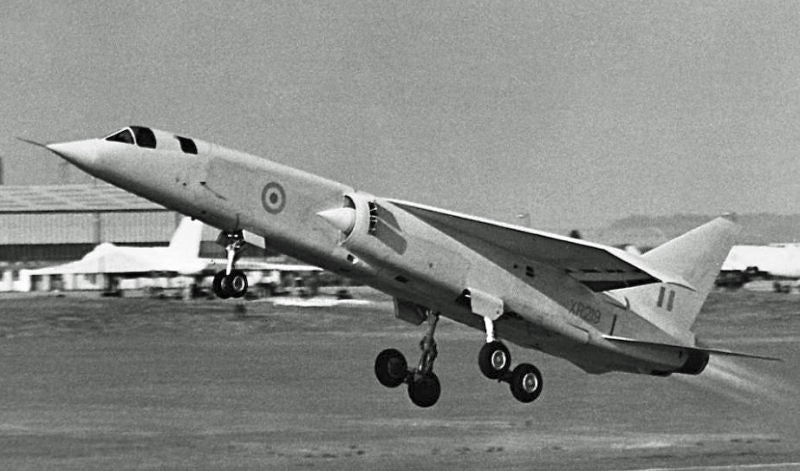
September 27, 1964 – The first flight of the BAC TSR-2. By the 1950s, the general doctrine of aerial bombardment, either nuclear or conventional, was to penetrate enemy territory by flying as high and as fast as possible, beyond the reach of enemy fighters and interceptors. In England, the English Electric Canberra , which first flew in May 1949, had a service ceiling of 48,000 feet, which meant if could fly over enemy territory with relative impunity. But the arrival of the surface-to-air missile (SAM) changed conventional doctrine overnight, and a new breed of attack aircraft came to the fore, known as interdictors . Since radar-guided SAMS of the era worked on line of sight to track incoming targets, the solution was to fly as low as possible, under the radar, and use terrain features to further mask the attacking aircraft. These high speed, ground-hugging aircraft could carry either conventional or nuclear weapons and, at the time, their interdictor role called for them to fly deep behind enemy lines and destroy logistics targets such as airfields and railroad hubs, thus preventing the enemy from bringing troops and supplies to the front lines. To that end, the British government issued Operational Requirement 399 (GOR.399) in 1956, an extraordinarily ambitious list of requirements for a new light bomber that could fly at supersonic speeds in all weather conditions, be capable of carrying both tactical nuclear weapons and conventional weapons, have either short takeoff and landing (STOL) or vertical takeoff and landing (VTOL) capabilities, and also be able to perform reconnaissance missions. In January 1959, the Ministry of Supply selected a consortium of Vickers-Armstrongs and English Electric (which, along with the Bristol Aeroplane Company and Hunting Aircraft were forced into a merger in 1960 to form the British Aircraft Corporation , or BAC) to produce what would be called the TRS-2 (Tactical Strike Reconnaissance, Mach 2). The new aircraft would was designed around the strengths of each company, with Vickers-Armstrongs building the front half of the aircraft and wings, while English Electric built the rear.

The TSR-2 was powered by two Bristol-Siddeley Olympus afterburning turbojets developed from those used on the Avro Vulcan , engines which would later power the Concorde . It was capable of a sustained cruise of Mach 2.05, with a dash speed of Mach 2.35, and a theoretical top speed of Mach 3. In an effort to save money, no prototypes were built. The first tranche of aircraft were supposed to be finished production aircraft, and testing commenced with the first two completed aircraft. Despite some early mechanical difficulties, test pilots reported that the TSR-2 flew well. Still, the initial requirements had to be reworked to reflect the realities of the TSR-2's performance. While the first aircraft was supposed to be a finished production airframe, the sophisticated radars and other electronics had yet to be installed, and the costs of the aircraft continued to climb. With some in the British government believing that the TSR was made obsolete by the ICBM , the cost and complexity, as well as delays in development, led to the project’s cancellation on April 6, 1965, the day scheduled for the maiden flight of the second aircraft. Following contentious debate, the British government announced that it would procure the General Dynamics F-111 rather than develop their own interdictor, even though considerable money and effort had already been put into the TSR-2. And, to add insult to injury, the British government later rescinded their order of F-111s when that program ran into it own costly delays. Within six months of cancellation, all uncompleted aircraft, plus all tooling, were scrapped, and only two aircraft survived, neither of which is complete. The two finished aircraft, including the one that took part in testing, were destroyed to test for weaknesses in the airframe to gunfire and shrapnel. Only one completed aircraft survived, and is housed at the RAF Museum, Cosford. A second airframe, much less complete, resides at the Imperial War Museum Duxford. (First photo author unknown; second photo by Mike Freer via Wikimedia Commons )
!!! UNKNOWN CONTENT TYPE !!!
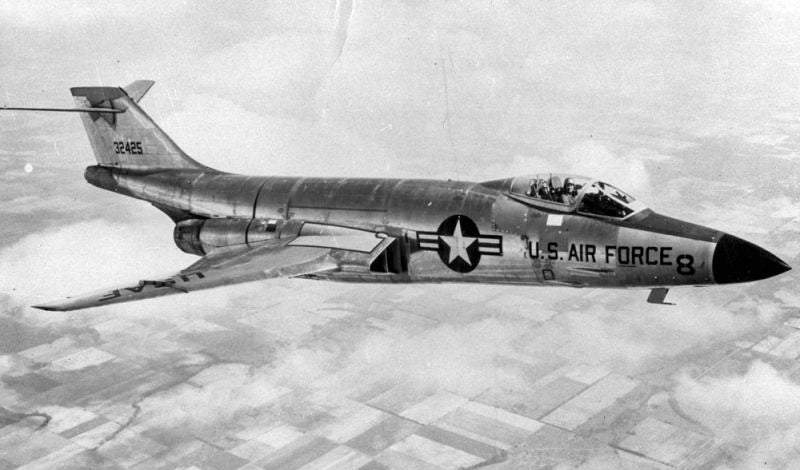
September 29, 1954 – The first flight of the McDonnell F-101 Voodoo. During WWII, huge formations of Allied bombers ranged the skies over Europe and the Pacific, protected from enemy fighters by a surrounding screen of fighter escorts. In the first few years following the war, and before the arrival of the intercontinental ballistic missile (ICBM) and high altitude surface-to-air missiles (SAMs), the method of penetrating enemy airspace continued basically unchanged, though the fighters and some newer bombers were now powered by jet engines instead of piston engines. To combat the expected waves of Russian bombers should the Cold War turn hot, a new breed of fighter was needed, so-called penetration fighters , purpose-built to fly fast and stop enemy bombers before they could reach their target. In 1946, the US Air Forced issued requirements for a jet-powered penetration fighter, and three manufacturers responded: McDonnell Aircraft presented the XF-88 Voodoo , Lockheed developed the XF-90 , and North American built the YF-93 . McDonnell won the competition but, following the detonation of the first nuclear bomb by the Soviet Union in 1949, the Air Force turned their attention to creating interceptors, and the penetration fighter project was shelved for a time. But with America’s entry into the Korean war in 1950, the Air Force discovered that there was still a need for bomber escorts and, in 1951, the Air Force once again issued an operational requirement for a penetration fighter. And once again, they tapped McDonnell to build it. But this time, McDonnell responded with a much better airplane. The F-101 was based on the earlier XF-88 Voodoo , and it retained the Voodoo nickname, but the new fighter was made much larger to accommodate three times the fuel capacity of the XF-88 as well as a larger radar. The F-101 also received more powerful Pratt & Whitney J57 turbojets, and the horizontal stabilizer was moved to the top of the tail to provide greater stability at high speeds. The F-101A entered service with the Strategic Air Command (SAC), but was only built in small numbers because the need for a penetration fighter soon became secondary to the need for an interceptor. So the F-101A was shifted to the Tactical Air Command (TAC) in 1957, where its designation changed to strategic fighter, and it was used to carry a single nuclear bomb for tactical strikes against enemy airfields or other important military targets of immediate value. At the same time as development of the F-101 was underway, the Air Force was working on the 1954 interceptor , a project designed to create a dedicated, state-of-the-art interceptor to combat Russian bombers, a project that eventually led to the Convair F-102 Delta Dagger and F-106 Delta Dart . But lengthy delays in that program meant that these aircraft would not be ready on schedule, and the Voodoo was transformed into an interim interceptor as the F-101B.
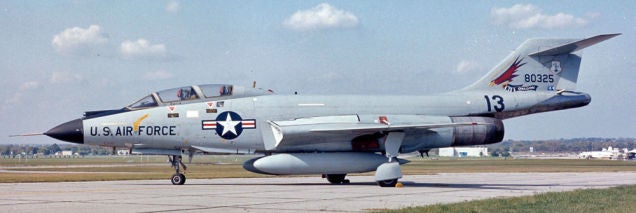
The B model received more powerful J57 engines with significantly longer afterburners which increased top speed to Mach 1.8. This variant had a two-seat tandem cockpit for pilot and weapons officer, and was fitted with the Hughes MG-13 fire control radar along with the Semi-Automatic Ground Environment (SAGE) system which permitted controllers on the ground to remotely direct the aircraft to its target. The internal cannons were removed and replaced by four AIM-4 Falcon air-to-air missiles. More Voodoos were produced in this interceptor variant than any other. The Voodoo was also developed into the reconnaissance RF-101, which served longer than any of the fighter/interceptor variants, and saw extensive action in the Vietnam War. The RF-101 also took part in reconnaissance missions over Cuba during the Cuban Missile Crisis . The Voodoo was retired by frontline USAF units by 1972, but would continue to serve the Air National Guard for 10 more years. The F-101 was exported to China and Canada, where Canadian Voodos flew with the Royal Canadian Air Force as the CF-101 , replacing the Avro Canada CF-100 Canuck . The RCAF finally retired their Voodoos in 1984 with the arrival of the McDonnell Douglas CF-18 Hornet . (US Air Force photos)
!!! UNKNOWN CONTENT TYPE !!!
!!! UNKNOWN CONTENT TYPE !!!
!!! UNKNOWN CONTENT TYPE !!!
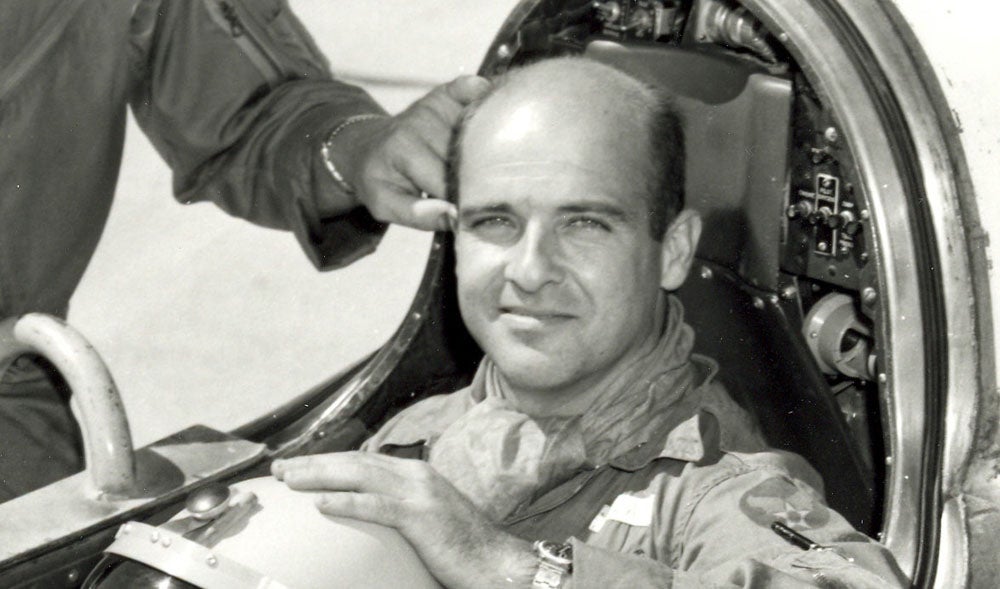
September 27, 1956 – The death of Milburn G. “Mel” Apt. Apt was born on April 9, 1924 in Buffalo, Kansas and joined the US Army Air Forces in 1944. Following his military service, Apt received a degree in aeronautical engineering and graduated from the Experimental Flight Test School in 1954. As a test pilot, Apt flew the Bell X-2 rocket plane and became the first person to exceed Mach 3. After the rocket motor burned out, Apt attempted to return to base, still flying at Mach 3. Apt lost control of the X-2, and as the aircraft tumbled through the sky he initiated the separation of the escape capsule. While the capsule’s drogue chute opened, the main chute did not, and Apt was killed when the capsule struck the ground. (US Air Force photo)
!!! UNKNOWN CONTENT TYPE !!!
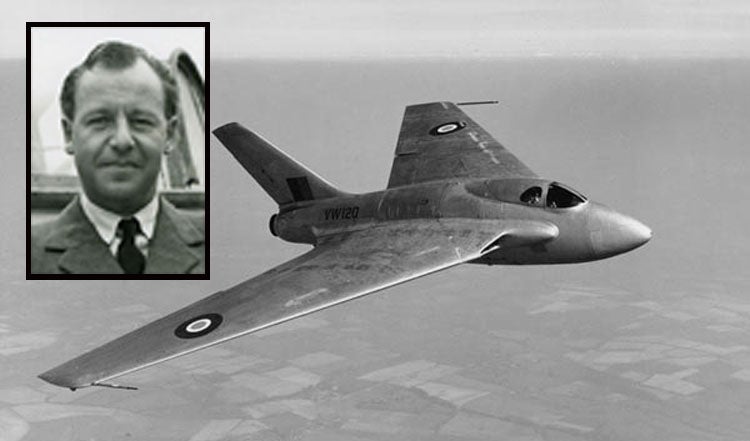
September 27, 1946 – The death of Geoffrey de Havilland, Jr, OBE. De Havilland was born on February 18, 1910, the son of famed aircraft designer Geoffrey de Havilland . He served as the chief test pilot for the de Havilland Aircraft Company , performed the maiden flights of the de Havilland Mosquito and the jet-powered de Havilland Vampire , and was awarded the Order of the British Empire in 1945. During a test flight of the de Havilland DH 108 Swallow , a radical tailless aircraft based on the Messerschmitt Me 163 Komet , de Havilland lost control of the aircraft before it broke up and crashed. Investigators determined that de Havilland had died when his head struck the canopy during the violent oscillations, breaking his neck. (Photo authors unknown via The Tartan Terror )
!!! UNKNOWN CONTENT TYPE !!!
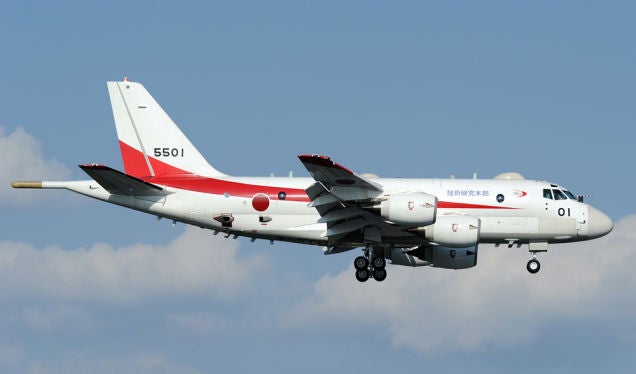
September 28, 2007 – The first flight of the Kawasaki P-1,
a domestically-produced maritime patrol aircraft designed to replace the
Lockheed P-3C Orion
. The P-1 entered service with the
Japan Maritime Self-Defense Force
in 2013, and is outfitted with a magnetic anomaly detection boom, sonobuoys, bombs and missiles. Thirty-three aircraft have been produced to date, and Kawasaki are in talks to sell the P-1 to the RAF to replace their aging fleet of
Hawker Siddeley Nimrods
. Unlike many other maritime patrol planes that were developed from existing airliners, the P-1 was purpose-built for the maritime reconnaissance role, and is the first production aircraft to use “
fly-by-optics
” technology.
(Photo by Toshiro Aoki via
Wikimedia Commons
)
!!! UNKNOWN CONTENT TYPE !!!
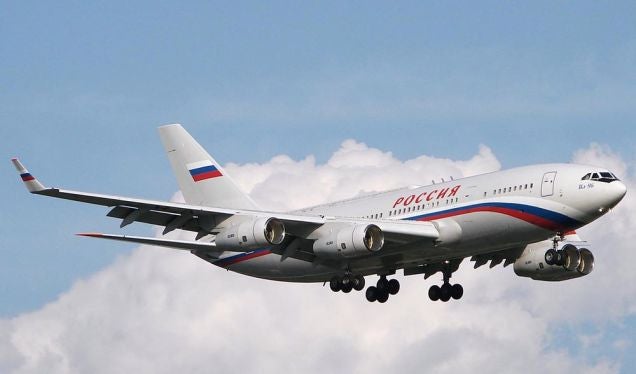
September 28, 1988 – The first flight of the Ilyushin Il-96, a long-haul, widebody, four-engine airliner that entered service with Soviet flag carrier airline Aeroflot in 1992. The Il-96 is a development of the Soviet Union’s first wide body airliner, the Ilyushin Il-86 , which first flew in 1976, and features a shortened fuselage, supercritical wing , winglets, glass cockpit and fly-by-wire control systems. Thirty airliners have been produced as of 2015, and the largest variant, the Il-96-400, can accommodate up to 436 passengers in a single-class configuration. (Photo by E233renmei via Wikimedia Commons )
!!! UNKNOWN CONTENT TYPE !!!
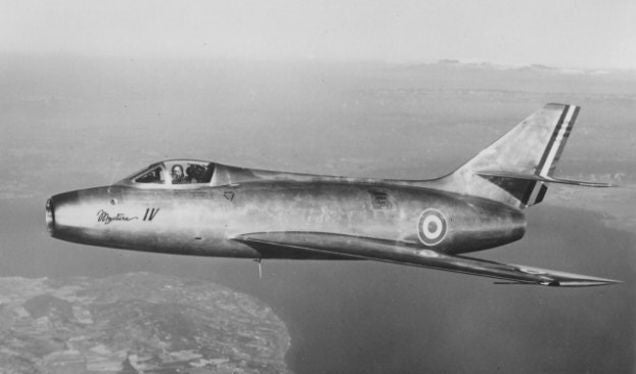
September 28, 1952 – The first flight of the Dassault Mystère IV, the first transonic fighter to enter service with the Armée de l’Air . The Mystère IV was an evolutionary development of the earlier Mystère II and, though sharing an outward resemblance to the earlier fighter, was a completely new design featuring improvements in aerodynamics and a more powerful Hispano-Suiza Verdon turbojet engine. The Mystère IV served from 1953 until the mid-1980s, saw action in the Suez Crisis of 1956, and also served in the air forces of Israel and India. (Photo author unknown)
!!! UNKNOWN CONTENT TYPE !!!
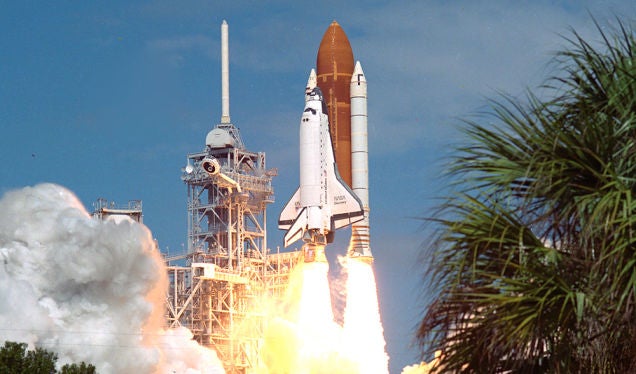
September 29, 1988 – The launch of Space Shuttle Discovery on ST-26, the first flight following the Challenger Disaster. After the loss of the Shuttle Challenger on January 28, 1986, STS-26 was declared the “Return to Flight” mission after an almost three-year hiatus in Shuttle missions. It was the first flight to have all crew members wear pressure suits, and the first with a crew bailout contingency since STS-4 . It was aslso the first mission since Apollo 11 where all crew members had been on at least one previous space mission. Discovery launched from Kennedy Space Center in Florida and spent 4 days in orbit where it deployed a Tracking and Data Relay Satellite (TDRS). It was also the first spacecraft to fly with a Voice Control Unit (VCU), a computer capable of interpreting and acting on voice commands. (NASA photo)
!!! UNKNOWN CONTENT TYPE !!!
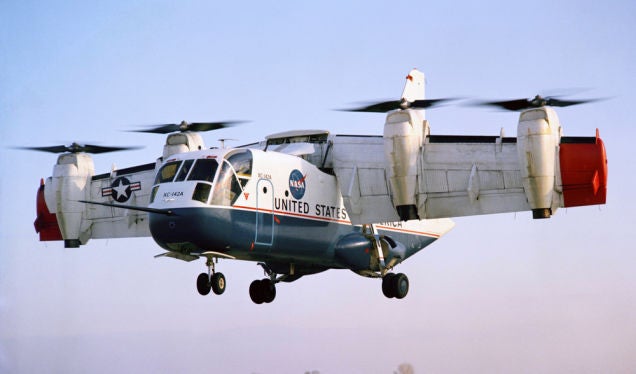
September 29, 1964 – The first flight of the LTV XC-142, an experimental vertical/short takeoff and landing (V/STOL) transport and cargo aircraft developed for the US Army, Navy and Air Force. The goal of the XC-142 was to provide an aircraft with helicopter-like performance but with greater range and speed than possible with a helicopter. The XC-142 was powered by four General Electric T64 turboshaft engines linked by a common drive shaft that also turned a small horizontal propeller on the tail to control pitch during hover. Yaw during hover was controlled by the ailerons. In testing, the XC-142 completed all phases of hover and transition to level flight, but the project was canceled after 5 prototypes were built, and the aircraft are turned over to NASA for testing. One remains today at the National Museum of the US Air Force . (NASA photo)
!!! UNKNOWN CONTENT TYPE !!!
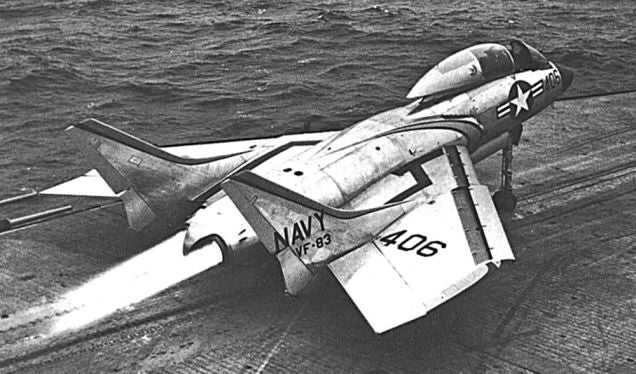
September 29, 1948 – The first flight of the Vought XF7U-1 Cutlass. Allegedly based on design concepts captured from the German Arado Flugzeugwerke at the end of WWII, the Cutlass had a short, checkered career with the US Navy. A radical tailless design with twin vertical stabilizers, the Cutlass suffered from serious handling problems and underpowered engines, and its long nose gear caused difficulty with carrier landings and lead to numerous crashes and pilot fatalities. The Cutlass was introduced in 1951 and served for only eight years before being replaced by the extremely successful Vought F8U Crusader . (US Navy photo)
!!! UNKNOWN CONTENT TYPE !!!

September 29, 1940 – The Brocklesby mid-air collision. During a training flight over Brocklesby, Australia, two Avro Ansons collided in midair and became locked together. The pilot of the lower Anson bailed out, along with the navigators of both aircraft. The collision caused the engines to stop on the upper aircraft; however, the engines on the lower Anson continued to run at full power, and the pilot of the upper Anson found he could control the connected aircraft using his ailerons and flaps. After flying 5 miles with the planes connected, the pilot made an emergency landing in a pasture. Only one member the crews suffered minor injuries. The upper aircraft was subsequently repaired and returned to service. (Australian Government photo)
!!! UNKNOWN CONTENT TYPE !!!
!!! UNKNOWN CONTENT TYPE !!!
!!! UNKNOWN CONTENT TYPE !!!
!!! UNKNOWN CONTENT TYPE !!!
!!! UNKNOWN CONTENT TYPE !!!
!!! UNKNOWN CONTENT TYPE !!!
!!! UNKNOWN CONTENT TYPE !!!
If you enjoy these Aviation History posts, please let me know in the comments. And if you missed any of the past articles, you can find them all at
Planelopnik History
. You can also find more stories about aviation, aviators and airplane oddities at
Wingspan
and
Planes You’ve (Probably) Never Heard Of
.
!!! UNKNOWN CONTENT TYPE !!!
 "Turbineguy: Nom de Zoom" (will-alib)
"Turbineguy: Nom de Zoom" (will-alib)
09/29/2017 at 13:25, STARS: 1
Looking at the wing planform of the TSR-2, my first thought was “How the hell did that get airborne?” Then I remembered the F-104. ::shrugs::
 "Chariotoflove" (chariotoflove)
"Chariotoflove" (chariotoflove)
09/29/2017 at 13:31, STARS: 2
That Australian crash is crazy. You couldn’t make that up. Well, you could, but no one would call it believable.

09/29/2017 at 13:37, STARS: 1
Strap powerful enough engines to it, and you can make a brick fly. See also: F-4
 "Turbineguy: Nom de Zoom" (will-alib)
"Turbineguy: Nom de Zoom" (will-alib)
09/29/2017 at 13:42, STARS: 3
Yes, but unlike your garden-variety brick the Phantom is pointy at one end.
 "S65" (granthp)
"S65" (granthp)
09/29/2017 at 13:51, STARS: 1
Good job, as usual. I always enjoy these posts

09/29/2017 at 13:53, STARS: 1
True, but the proportion of wings to fuselage is about the same.
 "ttyymmnn" (ttyymmnn)
"ttyymmnn" (ttyymmnn)
09/29/2017 at 13:57, STARS: 1
Thanks, and thanks for reading!
 "ttyymmnn" (ttyymmnn)
"ttyymmnn" (ttyymmnn)
09/29/2017 at 13:57, STARS: 1
I was just about to say that very thing. Great minds....

09/29/2017 at 14:12, STARS: 1
And sixty some-odd years later, it would give the guys at Top Gear ideas ...
 "AuthiCooper1300" (rexrod)
"AuthiCooper1300" (rexrod)
09/29/2017 at 15:06, STARS: 1
From Wolfe’s The Right Stuff:
“Pilots were already beginning to crunch the F-104 simply because the engine flamed out and they fell to the ground with about as much glide as a set of car keys.”

09/29/2017 at 15:14, STARS: 2
If a West German wanted an F-104, the joke went, they just bought a piece of land and waited.

09/29/2017 at 15:21, STARS: 0
My brain hurts looking at that pic of the Gutless Cutlass: he’s taking off on full burner, but the canopy’s open. It’s terrifying though, of the 320 F7Us built, over one quarter of them were destroyed in accidents.
 "AuthiCooper1300" (rexrod)
"AuthiCooper1300" (rexrod)
09/29/2017 at 15:24, STARS: 1
Once I met once a guy in Germany who had done the civil service (instead of the military one) and one of his tasks was to help in the retrieval of evidence from aircraft crashes. It seems he saw once a J79 engine shaft buried ten metres into the ground (or something crazy like that). Gives a whole new meaning to the expression “lawn dart”.
In all fairness the problem with the Luftwaffe’s F-104s was that it was not quite the most appropriate a/c for its intended use/mission profiles given Germany’s decidedly not mild weather patterns.
Having said that there is a harrowing story about one aircraft whose oxygen supply malfunctioned, killing the pilot, and kept flying north until shot down by the Swedes (or was it the Danes?).
 "ttyymmnn" (ttyymmnn)
"ttyymmnn" (ttyymmnn)
09/29/2017 at 15:55, STARS: 1
Navy pilots persisted with the open canopy on takeoff and landing for a long time. It was a holdover from the WWII days, before ejection seats, when they wanted to be able to get out fast if they went in the drink. I can’t find the first Navy fighter to use an ejection seat, or when the 0-0 seat was introduced, but it was sometime after 1961. The Cutlass was retired two years before that. Here’s a graphic demonstration of why they did it.
!!! UNKNOWN CONTENT TYPE !!!
 "Turbineguy: Nom de Zoom" (will-alib)
"Turbineguy: Nom de Zoom" (will-alib)
09/29/2017 at 17:56, STARS: 0
Japan flew them too. I wonder if their experience was any better.
 "Dusty Ventures" (dustyventures)
"Dusty Ventures" (dustyventures)
09/29/2017 at 21:23, STARS: 1
Shit, that’s a terrifying way to go
 "ttyymmnn" (ttyymmnn)
"ttyymmnn" (ttyymmnn)
09/29/2017 at 22:04, STARS: 0
Agreed.